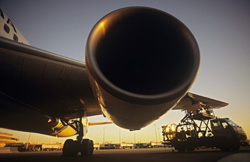Understanding engine noise to reduce it
Noise abatement is an increasingly important consideration in aircraft design. In conventional commercial aircraft, analysing the sources of noise is a challenging problem due to the complex systems and geometries. Turboshaft engines are a model system for analysing aircraft noise and are also important in their own right. These engines optimise shaft power rather than jet thrust and are commonly used in helicopters, another aircraft producing a tremendous amount of noise. Exhaust broadband noise (from 0 to 4 kilohertz (kHz)) is the second most dominant noise, primarily due to combustion and turbine noise (where the hot exhaust turns the blades) with very little contribution from the jet. Thus, it is representative of core engine noise and provides a simpler geometry without parasitic noise to study the complex topic of aircraft noise generation. EU-funded scientists working on the project 'Turboshaft engine exhaust noise identification' (TEENI) chose this simpler system representative of airplane gas turbines and critical to the minimisation of helicopter noise to address noise in general. In order to identify and thus minimise core engine noise, scientists developed novel pressure and temperature sensors compatible with the harsh engine environment to measure dynamic engine parameters. They correlated noise measured in the far field with internal measurements. Noise sources breakdown techniques (NSBTs) developed within the project were used to determine the dominant sources of noise emission. The team also developed models to evaluate noise generation, propagation and radiation through the turbine exhaust. Full-scale turboshaft engine testing facilitated the population of a comprehensive database, the first of its kind. Overall, the project demonstrated that low frequency noise was largely due to combustion. The noise contribution of the high pressure turbine was mainly at high frequencies. Broadband noise for frequencies greater than 2 kHz was not fully explained and points the way to directions for future research. TEENI models and sensors are an important contribution to the toolkit required by aircraft designers and manufacturers, and promise to enhance understanding and thus facilitate noise reduction and certification. They should have commercialisation opportunities in numerous other fields as well.







